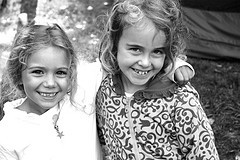The last posting was about the benefits of conflict and why we need to teach kids to resolve conflict constructively themselves. This posting will teach you how to do it.
You might be thinking that this is a posting for parents of older kids and teens. And it is. But it is also important to start teaching constructive conflict resolution skills pretty darn young. Recent research shows that kids as young as two can be taught to resolve many of their own conflicts without adult intervention.

Sign me up, I hear you saying. How is it that we teach kids to resolve their own conflicts? Doing all this research on conflict resolution has given me some insight into why my constant refrain ("Would you guys just knock it off?!") is so spectacularly ineffective when my children are bickering. When kids fight, we need to mediate their conflict until they learn to do this themselves.
Positive conflict resolution is pretty simple, but unless you are a lot smarter than me (entirely possible) you might need to reference this list a few times to get the hang of it.
10 Steps to Peace in Your Household
![]()
- Breathe. If you are anything like me, arguing kids make me tense and prone to, uh, yelling. We don't make effective mediators when we are angry or upset. I often need to take a few deep breaths to center myself before entering the fray. Unless the action is escalating wildly, take a second to go get your handy printed "10 Steps to Peace List."
- Address the situation. Paradoxically, peacemaking requires confrontation. We often need to help arguing kids realize that they are experiencing a conflict that they need to resolve themselves. It is too hard for kids to manage something they can't name or even see is happening.
- Now help them calm down and gain some distance from negative emotions. Conflicts cannot be resolved productively until the "heat" of the moment passes. One way to speed this process is to create a conflict resolution area or time that promotes calm. This can be a peace table, a talking stick, or a family meeting. By making an actual physical space or dedicated time for conflict resolution, you can help kids step back and gain some perspective that will help them solve the conflict.
- Have each person state what they want. In one study, 40% of uncoached kids failed to state what they wanted out of the conflict resolution. Rule number one in getting what you want? Ask for it! What does each kid see as the problem? Each might describe something completely different, which is okay.
- Have each express their feelings. How is the conflict making them feel?
- Have them state the reasons that underlie what they want and how they are feeling.
- Have each person communicate their understanding of the other person's wants, feelings, and reasons. At this point, the problem is now their common ground, and they can work together to solve it.
- Change the focus. Instead of letting your little warriors continue to personalize the conflict (you hurt my feelings, you always get to play with the Target-knock-off-American-Girl-doll and I never do) refocus them on the conflict itself. It is now a problem they will solve together. One approach is to write the problem down and have the kids sit down together facing it.
- Ask them to invent together three or more solutions that meet the needs they expressed earlier. Especially with little kids, it is important to realize that the children's solutions may not seem like good ones. That doesn't matter, though, if the kids like their ideas and are able to agree on them. Note that this is not about having each come up with compromises—it is about finding the win-win.
- Agree on the solution that maximizes both of people's benefits. Shake hands or hug, and go have some fun!
The other part of teaching kids to resolve their conflicts in a positive manner is easier said than done: we've gotta model positive conflict resolution skills ourselves. This means that I'll be using these 10 steps as a guide to solving my own conflicts with the kids, and to managing disagreements with their dad. Knowing all the benefits that conflict resolution skills bring to kids, I now want my kids to see conflicts as opportunities to listen and to learn, rather than to just quit it.
Each time we take kids through those 10 steps, they learn that they can solve problems in ways that make them feel competent and effective. They've increased their ability to cooperate, to empathize, and to build strong relationships. So conflict really is a good thing. And so are fights between friends. Why? Conflict provides the fuel for growth we all need to become healthy, happy, and resilient adults.
Feel free to reprint this article in your own blog or publication, but please link back to us or otherwise send your readers to www.GreaterGoodParents.org. And send us a copy!
10 steps adapted in part from Johnson & Johnson, Teaching Students to Be Peacemakers, 1995, in Stevahn, 2004.
© 2008 Christine Carter, Ph.D.
Join the Campaign for 100,000 Happier Parents by signing this simple pledge.
Become a fan of Raising Happiness on Facebook.
Follow Christine Carter on Twitter
Subscribe to the Happiness Matters Podcast on iTunes.


Comments
I love this article, and I wonder if you could expand on it and talk really specifically about how to do it with 2 and 3 year-olds? I’d be fascinated to do this with my 3 yr-old, but I don’t know if he’d stay in one place long enough to go through all those steps!
——-
Susannah | 11:04 pm, April 4, 2009 | Link